|| Take me back to the main ToolKit
page ||
|| Take me back to the DirectedCreativity Home page
||
Adapted from Creativity, Innovation, and Quality
by Paul E. Plsek (1997: Quality Press).
© 1997 Paul E. Plsek. All rights reserved. Click here for information on this book.
(A new window will open. Close it when you're finished and you will return
to this page)
"Imagination is more important than knowledge."
Albert Einstein
"Imagination makes man the paragon of
animals."
Shakespeare
"I have a microwave fireplace.
You can lay down in front of the fire all night...
in just eight minutes."
Steven Wright
The Imagination phase is the heart of the DirectedCreativity Cycle. It is what people are usually referring to when they talk about creative thinking.
Information on this page...
|| Activities in the
Imagination Phase of the DirectedCreativity Cycle ||
|| Imagination and the Three Principles ||
|| Key Heuristics for Imagination ||
|| Map of the Tools for Imagination ||
|| Outline Descriptions of the Tools for Imagination
||
|| Summary of the Imagination Phase ||
Click on the up arrow ![]() to return to this navigation
menu
to return to this navigation
menu
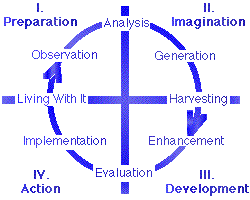
The analysis of the Preparation phase creates a store of concepts
in our memories. Using this store, we generate novel ideas to meet
specific needs by actively searching for novel associations among concepts.
Seeking the balance between satisficing and premature judgment, we will
then harvest several of our imaginative ideas for further development
in the next phase of the Directed Creativity Cycle.![]()
The Imagination phase primarily utilizes escape and movement.
Our imaginations possess the wonderful ability to escape the confines of our current thinking on a topic. We are all capable of imagining whole new worlds, new rules, and new ways of doing things.
Equally wonderful is the power of mental movement. Our minds are constantly at work. It is extremely difficult to not think. When mental escape breaks the bonds of the current reality, mental movement finds another place to settle. If we direct our mental movement towards novel connections, we end up with creative ideas.
The keys to imagination are captured in the mental actions of:
The try for original ideas by novel associations heuristic is the heart of the Imagination phase of the DirectedCreativity Cycle. We purposefully direct our mental movement toward these novel associations. While judgment is needed to harvest promising innovations from among the virtually infinite array of possible mental associations, premature judgment is a significant barrier to imagination. The no inherent right or wrong heuristic encourages us to be flexible in our thinking during the Imagination phase. In so many cases in the work world, our notions of what is right or wrong, acceptable or not, sensible or eccentric are just relics of someone else's past judgment. Cultivate flexibility in your thinking by: (1) demystifying the history of how things got the way they are, and (2) realizing that you can always reinstate any rule or convention that you temporarily escape. The examine ideas that make you laugh heuristic suggests that laughter might well be the body's reaction to a novel connection among neurons in the brain. Therefore, during the Imagination phase, be prepared to explore thoughts that seem a little nutty the first time you hear them. Prepare groups in advance for this by explaining the theory. Do not let your idea generation session degenerate into a joke telling contest, but do not stifle humor. Finally, remember the implement a few ideas heuristic. Imagination is boundless and fun. While we can always do another round of imagination, remember that idea generation without action is creativity without innovation. Our organizations need innovation. Our customers want innovation. Our competitors will provide innovation if we don't. Keep telling yourself and your groups that one good idea implemented is better than ten great ideas still on paper. Set a time limit for the Imagination phase and respect it. Move on to Development and Action, and then begin the DirectedCreativity Cycle again. |
The keys to imagination are captured in the mental actions of:
The tools we need are tools that support these activities. We will look at several examples of tools from the creativity literature, but anything that helps us accomplish one or more of these six mental activities will help us to be more imaginative in our thought.
There are hundreds of tools in the literature that support creative imagination. The loose classification scheme below brings some order to this seemingly chaotic array of methods. The headings at the end of each spine on the diagram describe major categories of tools. The items coming off the spines represent subsets of tools under each category.
Click around on the map for explanations of the tools. Or, if you prefer,
you can simply continue scrolling down and read all the explanations of
all the tools.![]()
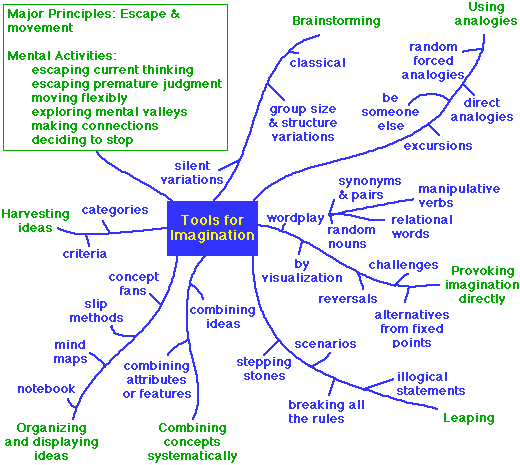
This mind map is a "loose" classification scheme.
Our judgment and perception systems have a strong tendency to lock onto
classification schemes. This leads to a strong and automatic desire to make
all future input conform to the scheme. We emphatically do not want that
to happen here. The mind map above is merely a device to enable us to present
the tools in an orderly manner.![]()
Provoking Imagination Directly
Combining Concepts Systematically
Organizing and Displaying Ideas
Alex Osborn's Original Rules of Brainstorming Criticism is ruled out Freewheeling is welcome Quantity is wanted Combination and improvement are sought |
| Classic brainstorming | Participants agree to the rules and express ideas verbally |
| Mitsubishi method | Participants write down their ideas in a silent period before verbal contributions begin |
| Brainwriting pool | Participants write down ideas and place them in a pile; someone else will later read them aloud to the group |
| Collective notebook | Participants submit ideas on a given topic without ever having a face-to-face meeting |
| Phillips 66 method | A large group is broken down into small groups of six. They have six minutes to generate ideas, which are then shared back in the larger group for harvesting. The six-minute brainstorming period can be repeated several times to allow for combinations of ideas. |
Others have suggested variants involving multiple groups in different locations, the use of multiple groups with slightly different problem statements, "musical chairs" approaches where participants constantly change groups, five minute periods of silence between idea generation bursts, and so on.
The purpose behind variants of brainstorming is to create an environment that reduces barriers to free participation and increases the number of ideas generated.
Try anything you can think of that does not contradict Osborn's four
basic rules and that seems to meet your needs. But remember that simply
removing barriers to participation and exhorting for quantity may not help
people come up with novel ideas. The basic assumption behind all brainstorming
methods is that the novel ideas are already there; waiting to be invited
out. (Click here to learn
why brainstorming is a weak tool for creative thinking.)
| Method: Randomly select verbs, conjunctions, prepositions, or nouns and use these to stimulate creative thinking on your topic. (See lists below.) Use combinations of key words from your topic statement to stimulate creative thoughts. (This is described in the Tools for Preparation section of this Toolkit.) |
List of Manipulative Verbs
(Sources: Osborn 1953, Koberg and Bagnall 1981, Higgins 1994, von Oech 1986)
| magnify | minify | rearrange | alter | adapt |
| modify | substitute | reverse | combine | harden |
| multiply | divide | subdue | squeeze | separate |
| transpose | compare | rotate | invert | soften |
| by-pass | widen | thicken | protect | integrate |
| dissect | eliminate | repel | flatten | symbolize |
List of Relational Words (Prepositions and Conjunctions)
(Sources: Crovitz, 1970; VanGundy, 1992)
| about | above | after | against | along |
| among | and | around | as | at |
| because | before | behind | beside | between |
| beyond | but | by | down | during |
| except | for | from | if | in |
| into | near | not | now | of |
| off | on | opposite | or | out |
| over | past | round | since | so |
| still | then | though | through | till |
| to | toward | under | up | when |
| where | while | with | within | without |
List of Random Nouns
(Sources: de Bono, 1967, 1969, 1992; von Oech, 1983, 1986; Michalko, 1991)
tongue plastic wrench star gourmet money flashlight dice windsurfer ribbon camera can pencil pin watermelon soda tape necklace mold gutter jewel house gully fuel music toe wastebasket x-ray cup paint lamb stomach rain telescope knee pole champagne top beans angel student lips salmon lungs gasoline tub fox chimney bikini prison tax igloo fireplace ax smoke referee cork stream strip jellyfish vines bomb umbrella cone flood frog rib table flower towel window locker toy podium saucer rainbow amoebae disk snail rice grass fence horse shed leaves bird tractor Olympics straw mirror chapter vacuum bread cyclone gravy emerald gang pliers binoculars studio parakeet fingernail meadow bat curb zipper gutter outlet elbow weeds paper wig road sauna cord duck floor book announcer diaper cake terrorist cookie lemon speaker |
Examples From SJ&D
Let's first try some manipulative verbs. Simply select a verb from the list and then let mental movement find a way to apply it to your topic. In our case, developing innovative services for SJ&D...
Verb |
Idea |
| minify | Make it easy for small businesses to set up Keogh and 401(k) retirement plans by developing a "kit" of plans and forms. |
| combine | Building on the idea above, develop a relationship with a discount brokerage firm who could seamlessly handle the investment side of retirement planning. |
| reverse | Thinking about getting clients to do our work... We could set up training programs to teach practical accounting to designated employees of the client's company. We would then provide a service of supervising these people. Clients might like it because we would be helping them develop their current employees. |
Every idea is a good one at this point and all our judgments should be positive in nature. In other words, we want to have on both the green (creative) and yellow (positive) hats from Edward de Bono's Six Thinking Hats. We are not looking for a specific response; there is no right answer.
We can also use relational prepositions and conjunctions. To use these, select two major elements associated with the topic of interest. For Steven Ross, potential element pairs might be: accountants and clients, tax returns and payroll records, clients and capital formation, and so on. Let's work with the two elements "clients and capital formation." Next, select at random a relational word: opposite. Now, explore the image of "clients as the opposite of capital formation."
Our clients are often "opponents" in the competition for a limited capital pool from the banks and venture capitalists in our community. We could set up some sort of cooperative among our clients to share the capital pool better. We would be at the center of this as a broker-networker. Instead of thinking of our clients as the opposite of investors or venture capitalists, we can encourage them to become venture capitalists themselves. We could help forge relationships among our clients in which they supply capital for each other's businesses around specific projects where there is a mutual benefit. |
| Method: Focus on something specific within the topic area. Identify the fixed point(s) by asking: what is the purpose here? what is happening? or where is the value in this? Now brainstorm alternative ways of realizing this fixed point. The result can be captured in a diagram like the one below. Source: de Bono 1992. |
Examples From SJ&D
Let's focus on the reception area of the accounting firm. What is the purpose? What is happening there? What's the value of what goes on? The answers to these questions provide us with three fixed points, as shown in the bubbles below. Now we can brainstorm alternative means of accomplishing these things.
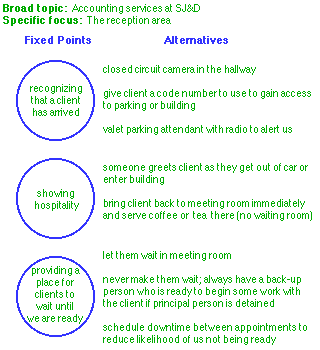
We can now craft several creative ideas from among these alternatives by using flexible mental movement. For example, we could...
Install motion detectors and closed circuit cameras in the hallway. A beep-tone would alert the receptionist that some one is coming. By looking at the camera and the appointment schedule, the receptionist could typically figure out who it is that is coming (at least narrow it down) and what meeting room they are to be escorted to. The receptionist mouse-clicks on the appointment schedule, sending an electronic message to the principle accountant and the back-up person to get ready for the appointment. Meanwhile, the receptionist goes out to greet the client at the door and escorts them directly to the designated meeting room. The receptionist stays with the client, serving coffee or tea, or just chatting, until someone arrives to begin the meeting. Instead of motion detectors and cameras, use the valet parking idea as the "front end" to the process above. The valet gets the person's name and radios this information ahead to us. We now have time to get ready to greet the client. |
| Method: Say outrageous things simply for the purpose of causing "outside the box" thinking. We simply jump over time, space, reason, and rules to find a new valley from which to commence our mental movement. The term "leaping" is meant to convey this sense of distance between our topic valley and the provoking valley. Sources: de Bono 1992 and von Oech 1984. |
Edward de Bono (1972) has coined the word "po" to signal a provocation statement for creative leaping. "Po" is a shorthand way of saying:
"I know that what I am about to say makes no sense. I have no reason for saying it other than the possibility that it might stimulate a creative thought. I do not know where it might lead, it might lead nowhere, but we will never know until after I say it and we think about it. While it will sound silly, I want us to take it seriously; as if it was very wise of me to say it. So here goes..."
We can generate stepping stones and illogical statements using the word po simply by asking people to say outrageous things pertaining to our topic of interest. There does not have to be a reason behind the statement.
Examples From SJ&D
Po, let's murder all of our clients.
Po, let's advise all of our clients to just stop paying taxes.
Totally outrageous! But, if we treat them as mystical wisdom statements and let our minds move, we may get a good idea. For example...
Murder clients... Do our clients have wills? Have they done adequate estate planning? Do they have succession plans for the leadership of their businesses? Clients stop paying taxes... There are ways to shield assets from taxes legally by placing them in trusts and off-shore accounts. Perhaps we could invite someone to conduct a seminar on this topic. If our clients seem interested, we could develop a service to make it easy for them to do this. |
We can also leap purposefully over any rule, law, or paradigm. Rather than trying to dismantle rules directly, creative thinkers often find that it is easier to simply leap over them temporarily to investigate what might be on the other side. Sometimes, we are so compelled by what we see on the other side of a rule, that we decide that it really is time to dismantle it. In other cases, we find that while the excursion was nice, we want to go back and live with the rule the way it is. This is OK. However, the more times we can get people to explore the world beyond a rule, the higher the likelihood that someday we will take it down.
Rules, laws, and paradigms that govern an accounting firm include:
Senior partners handle big accounts, juniors do delegated
work
We have an office; i.e., a building, a physical structure to work in
We must abide by the laws of our country and state
| Leaping over these rules, we could let junior accountants take on a few big accounts on their own to free up time for the senior partners to be more involved in the development of the innovative new services that are coming out of this exercise. We could experiment with letting people work out of home offices. We could set up small satellite offices in office parks in order to be closer to our customers. We could develop a mobile office in a van, complete with computers, cellular phone modems, and so on. We could take this service on the road at tax season, set up in shopping malls and neighborhoods, and do individual tax returns. All of these ideas are worth exploring, even if we do not decide to use them all. |
It may not be clear what creative ideas we can come up with by leaping over the legislated laws of the land (the final item on the previous list of rules). But it does make me wonder if there is an accounting firm anywhere that specializes in overseeing the financial matters of convicted white-collar criminals while they are, shall we say, otherwise engaged. I do not know if SJ&D wants to take on this dubious distinction, but you must admit it is a novel idea. SJ&D could become like a celebrated defense attorney who takes on even the most disgusting criminals as clients. There may be something useful in this idea. We will keep it for now.
Creative leaping can be great fun. Most people find that they really enjoy it; once they get the hang of it. For most people, this means learning to take the scenarios, stepping stones, po statements, and rule breaking suggestions seriously for a moment. We are so conditioned to think of laughter and pretending as not business-like, that we often find ourselves immediately rejecting these tools. Approach creative leap provocations initially as wisdom statements-like the statements that teachers of Eastern philosophy make. Forcing oneself to assume that there is wisdom there, challenges the analytical mind to find the wisdom in the seemingly non-sensical words. |
| Method: Identify key elements in the situation and write these as column headers in a table. List several alternatives under each element. Now, force several connections by running through the table picking up items from each column. The term "morphological approach" is sometimes used to describe this technique in the creativity literature. Sources: Koberg and Bagnall 1981, Zwicky 1966, and Crawford 1954. |
Examples From SJ&D
Let's apply this tool to the situation of quarterly financial statements produced by an accounting firm. A tabular listing of alternative attributes under four elements would include:
medium |
content |
audience |
format |
| paper | summary only | owner and key leaders only | tables of #s and text |
| computer files | include details | employees | include graphs |
| broadcast fax | include comments | local newspaper | include face plots |
| conference call | financial magazines | include sounds |
Now, we can force several connections by running through the table picking up items from each column. For example...
| We could have financial reports on paper, including comments, sent to financial magazines, with standard tables and text. Or, we could release the quarterly report via a conference call to the local newspapers, including comments, and including background music that reflects the tone of the report. |
There are at least 4x3x4x4=192 possible combinations from this simple four element table. A more complicated table would yield even more possibilities.
We can apply the general concept of systematically combining items to
any list of ideas. For example, we used a "morphological" approach
in generating ideas from the list of alternatives from fixed points in an
earlier example. Our final ideas were combinations of specific alternatives.
We could have systematically generated a large number of ideas by taking
one, two, three, or more of these alternatives at a time.
It is now time to begin winding down the idea generation and looking forward to action. One of the first things we need to do is organize the many ideas that we have generated. Organizing and displaying the ideas may trigger even more creative thoughts. We might be able to combine ideas, or see an opportunity to extend our creative thinking into underdeveloped areas. Organizing our ideas also prepares us for the more analytical tasks of harvesting and developing.
Idea notebooks provide a basic organizing technique. A simple notebook would comprise a listing of ideas, in no particular order, with each idea expressed as 1-4 sentences. The ideas can be entered into the notebook following each idea generation session. Keeping the list on a computer allows us to bring a bit more order to the compilation by listing the ideas under category headers.
We can supplement our idea notebooks with more detailed idea capture
worksheets, like the one shown below. Note that there is space on this worksheet
to record positives, negatives, and data needs associated with the idea
(de Bono's green, yellow, purple, and white thinking hats). You might also
want to record feelings about the idea (red hat); or other information such
as impact, potential cost, and so on.
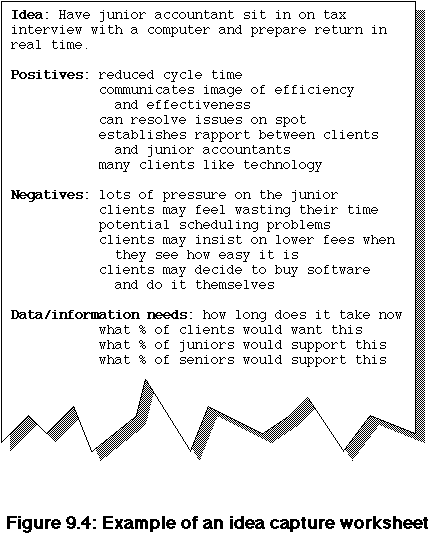
| Method: Start with a high-level process flowchart. Identify fixed point(s) behind each step of the process. Brainstorm alternatives. Use morphological runs through the resulting diagram to construct creative process redesigns. (Source: de Bono 1992.) The concept fan can be thought of as a "DirectedCreativity flowchart." |
Examples From SJ&D
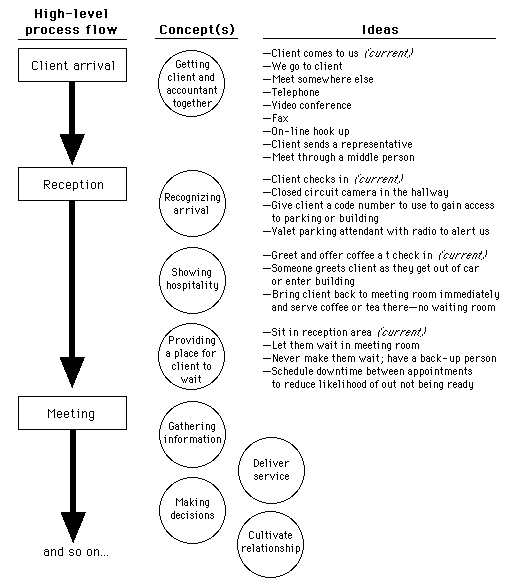
Just as a farmer harvesting grain brings in the entire crop for subsequent sorting and processing, so we will want to look at each idea that has been generated. In this initial harvesting, our objectives will be to do a rough sorting based on feasibility, and then see if we want to make any final efforts at idea generation prior to moving on toward action. We will conduct a second, final harvest as we begin the Development phase of the DirectedCreativity Cycle.
We begin by sorting the ideas into four categories:
| Ready to Use (RTU) | Ideas that we could act on very quickly. Need only a minimum of further study in order to get started on detailed implementation planning. |
| Seedlings (SEED) | Beginnings of a useful idea. Usable concept, but may not be able to do it exactly as stated. The basic idea itself needs more development before it is ready. |
| Useful Directions (UD) | A useful broad concept or general idea, but not really fleshed out well enough at this point to evaluate. Could be sent back for more specific idea generation. |
| Not Ready (NR) | An idea that is simply unusable at this point in time. Maybe someday, but not anytime soon. Use this category sparingly. |
It is important to note that, with the exception of the "not ready" category, we are rating the creative content of the ideas themselves, not our readiness or capability to implement them. A creative idea can be "ready to use" in the sense that we do not need more large doses of creative thought; but it may still take us six months and lots of detailed work to implement.
| This simple sorting and evaluation has accomplished the purposes of our initial harvesting. We have not made any final decisions yet; we are not committed to anything. That will come later. But, we now know where we can focus our development and action efforts if we want some immediate hits (the RTU items). We also are now in a position to commission some specific feasibility studies (the SEED items). And we can also now set up our final round of idea generation sessions (the UD items). Soon, we will be ready for full-scale critical evaluation, decision making, development and action; on our way to visible innovations in the marketplace. |
|
|| Take me back to the main ToolKit
page ||
|| Take me back to the DirectedCreativity Home page
||
© 1997 Paul E. Plsek & Associates, Inc.
All rights reserved.
Back to Top of
Page
Take me back to the DirectedCreativity
ToolKit page
|| Home Page || What's Directed Creativity? || Who's Paul Plsek? || Services
||
|| Links to Other Sites || The Creativity Bookstore ||
|| Creativity, Innovation,
and Quality by Paul Plsek ||
DirectedCreativity Theory, Methods, and Tools...
|| DirectedCreativity Cycle ||
|| DirectedCreativity Heuristics
||
|| DirectedCreativity Toolkit ||